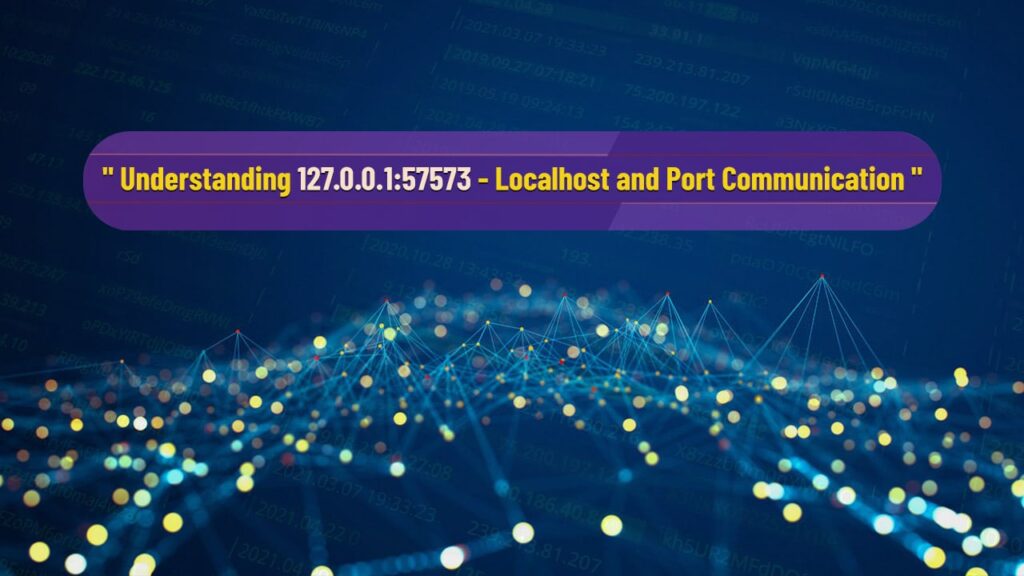In networking, understanding “127.0.0.1:57573” IP addresses and ports is essential for effective communication and troubleshooting. The IP address 127.0.0.1 and the port 57573 are integral parts of this system. 127.0.0.1 is known as the loopback address, while 57573 represents a specific port on that address. This article delves into the significance of these elements, their uses, and their impact on network functionality.
Table of Contents
What Is 127.0.0.1?
127.0.0.1 is an IP address that refers to the loopback interface of a computer. This address is unique because it directs traffic back to the same machine, rather than sending it out to the network. It serves as a testing and debugging tool for network applications, ensuring that they work correctly before deployment.

Why Use 127.0.0.1?
- Isolation for Testing: Using
127.0.0.1ensures that network communication remains local. This isolation prevents interference from external factors and helps developers and system administrators test applications without risking unintended interactions with other network services. - Network Diagnostics:
127.0.0.1is crucial for diagnosing network issues. By checking whether network services respond to requests on this address, users can determine if the problem lies within the local system or the broader network. - Security: Local communications on
127.0.0.1are confined to the machine, reducing security risks associated with external network communications. This controlled environment helps in identifying and fixing vulnerabilities without exposing them to outside threats.
The Role of Port Numbers
Ports are used to direct traffic to specific services or applications on a computer. Port numbers help differentiate between various services running on the same IP address. They range from 0 to 65535 and are categorized into three types: well-known ports, registered ports, and dynamic or ephemeral ports.
- Well-Known Ports (0-1023): Reserved for system or well-known services such as HTTP (80), HTTPS (443), and FTP (21).
- Registered Ports (1024-49151): Used by software applications that are not as universally recognized but are still specific to certain services.
- Dynamic or Ephemeral Ports (49152-65535): Temporary ports used for short-lived connections, often assigned dynamically by the operating system.
What Is 57573?
The port number 57573 falls into the dynamic or ephemeral range. This means it is typically assigned temporarily for a specific session or process. Dynamic ports are crucial for network communications that require temporary, unique endpoints.
Usage of Dynamic Ports
- Client-Server Communication: When a client connects to a server, the client often uses a dynamic port for the connection. This allows multiple connections to be handled simultaneously without conflicts.
- Application Testing: Developers use dynamic ports like
57573to test applications in isolation. These ports allow applications to run without interfering with other services on the same machine. - Network Protocols: Dynamic ports are employed in various network protocols to manage communication between different software applications. For example, protocols like FTP and SIP use dynamic ports to handle sessions and transactions.

Combining 127.0.0.1 and 57573
When combined, 127.0.0.1:57573 represents a specific endpoint on the local machine. This combination is commonly used for:
- Local Development: Developers use this setup to run and test web servers, databases, and other services locally. It ensures that changes can be tested in a controlled environment before deployment to a production server.
- Service Testing: Network engineers and system administrators use local addresses and ports to test services and configurations. This helps in diagnosing issues and verifying functionality without affecting external networks.
- Debugging: Debugging network applications often involves interacting with local services on specific ports. By using
127.0.0.1:57573, developers can ensure that their applications function correctly and efficiently.
Advanced Use Cases
- Virtualization and Containerization: In modern IT environments, virtualization and containerization technologies often rely on loopback addresses and dynamic ports. For instance, containers running on Docker may use
127.0.0.1with various ports to communicate internally. - Microservices Architecture: In microservices architecture, applications are split into smaller, independent services. Each service may use different ports on
127.0.0.1to communicate with other services within the same environment. - Network Monitoring: Network monitoring tools use loopback addresses to test and monitor the health of network services. This helps in identifying potential issues and ensuring that services are running smoothly.
Security Considerations
Although 127.0.0.1:57573 is used for local communication, security remains a concern. Here are some best practices to ensure security:
- Access Control: Implement access controls to restrict who can connect to services running on local addresses and ports. This prevents unauthorized access and potential exploitation.
- Regular Updates: Keep software and services updated to address any vulnerabilities that may be discovered. Regular updates help in maintaining the security of applications running on
127.0.0.1:57573. - Firewalls and Security Software: Use firewalls and security software to monitor and control traffic to and from local ports. This adds an additional layer of protection against potential threats.
Troubleshooting Common Issues
- Service Not Running: If a service is not responding on
127.0.0.1:57573, check if the service is running correctly. Ensure that there are no conflicts with other services using the same port. - Port Conflicts: Dynamic ports can sometimes conflict with other applications. Use tools like
netstatorlsofto identify which process is using a specific port and resolve any conflicts. - Network Configuration: Verify network configurations to ensure that
127.0.0.1and the specified port are correctly set up. Misconfigurations can prevent applications from communicating properly.
Conclusion
127.0.0.1:57573 represents a powerful combination of IP address and port number used for local communication, testing, and development. By understanding its role and applications, users can effectively utilize this setup for various purposes, from software development to network diagnostics. Ensuring proper security measures and troubleshooting practices will help maintain the integrity and functionality of applications running on this address and port.

FAQs About 127.0.0.1:57573
1. What is 127.0.0.1?
127.0.0.1 is the loopback IP address, which directs network traffic back to the same machine. It is used for testing and debugging purposes, allowing software and applications to communicate with themselves without accessing external networks.
2. What does the port number 57573 signify?
Port number 57573 is a dynamic or ephemeral port used temporarily by network applications for specific sessions. It allows multiple applications to use different ports simultaneously without conflicts.
3. Why is 127.0.0.1:57573 used in local development?
127.0.0.1:57573 is commonly used in local development for testing applications. It helps developers run and test software in isolation on their own machines, ensuring functionality before deployment to production environments.
4. How does 127.0.0.1:57573 help in debugging?
Using 127.0.0.1:57573 for debugging allows developers to test network services locally. It helps identify and resolve issues without affecting external systems, ensuring that applications work correctly in a controlled environment.
5. What are the security implications of using 127.0.0.1:57573?
While 127.0.0.1:57573 is used for local communication, security considerations include implementing access controls to restrict unauthorized access, keeping software updated to address vulnerabilities, and using firewalls and security software to monitor traffic.

